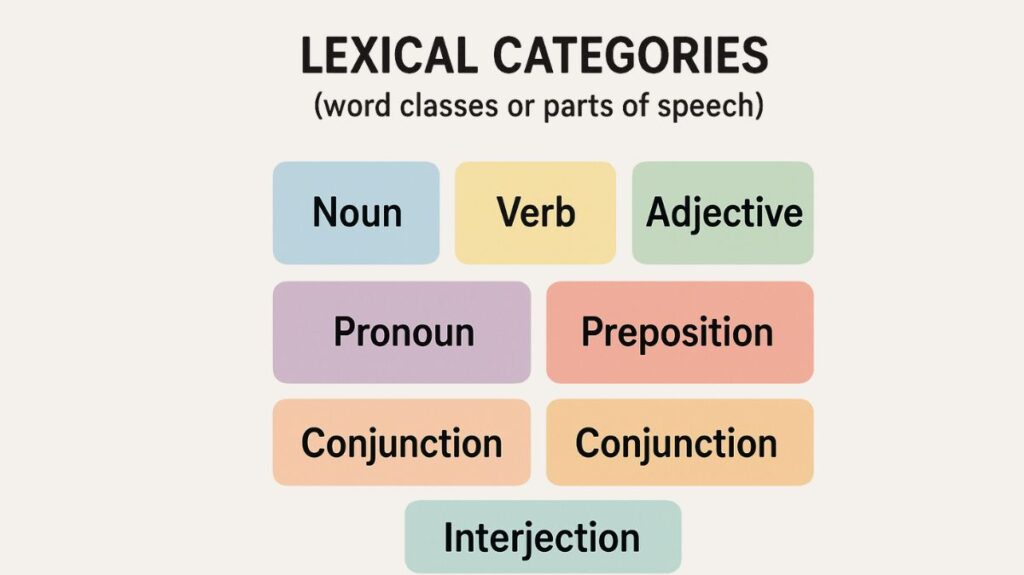Lexical Categories

Lexical categories are basic classifications used to organize words according to their common grammatical characteristics in Natural Language Processing (NLP). Another common name for them is word classes or parts-of-speech.
The process of automatically assigning these categories to words in a text is known as simply tagging, POS tagging, or part-of-speech tagging. In the standard NLP pipeline, POS tagging is seen as a crucial step that frequently comes after tokenization. Each phrase word must have a POS function tag. As many words may have several POS tags, the tagger must analyse the sentence’s lexical and syntactic properties to choose the most likely tag. This makes ambiguity in terminology plain and reveals the grammatical structure of a statement.
Characteristics of Lexical Categories
- Linguists generally concur that there are three main (basic) components of speech: nouns, verbs, and adjectives. There is disagreement about this; some people recognise contradictions and differentiate between “typical members” of each group.
- In addition to the major ones, adverbs, prepositions, and conjunctions are examples of frequent lexical categories.
- A limited number of closed class words which are very common, ambiguous, and serve as function words and open class words such as nouns, verbs, and adjectives are found in most languages.
- The majority of part-of-speech tags are morphosyntactic categories as opposed to strictly semantic ones. More than merely their meaning, they characterise words by their internal structure, including suffixes and prefixes, and how they pattern together. For example, although nouns can be things and verbs frequently represent activities, events can also be nouns.
Tagsets
A tagset consists of all the tags used for a specific job. Different part-of-speech tagsets are available, usually with 40–200 tags. Examples include tagsets that contain the following categories: determiner (DET), conjunction (CNJ), noun (N), verb (V), adjective (ADJ), adverb (ADV), pronoun (PRO), preposition (P), and punctuation symbols. The 36 elements of speech are utilised in the Penn Treebank corpus, a popular English corpus. To capture word classes in a variety of languages, the Universal Dependencies project created a tagset.
Automatic POS Tagging Techniques
POS tagging is a sort of sequence labelling task in which each element in an input sequence is given a unique label, known as the POS tag.
The following are some methods for automated tagging:
- N-gram taggers and Hidden Markov Models (HMM) are examples of statistical techniques. The sparse data problem can be addressed by N-gram taggers when n is greater.
- Machine learning methods include neural networks like Recurrent Neural Networks (RNNs), LSTMs, and Transformers (e.g., BERT), supervised classifiers, transformation-based learning, multilayer perceptron networks, decision tree classifiers, and conditional random fields (CRFs).
- The word itself, its prefixes and suffixes, capitalisation, surrounding words, and their tags are some of the characteristics that these models frequently use.
Role in the NLP Pipeline
- Lexical analysis breaks text into words and turns letters into lexemes, starting NLP.
- A important first step in NLP is POS tagging, which relies on sentence and word segmentation.
- Preprocessing is necessary for syntactic analysis, or parsing, which evaluates a sentence’s syntax, word arrangement, and word relationships. It is possible to see POS tagging as a low-level version of syntactic analysis.
- Higher-level NLP tasks, such as semantic role labelling, also make use of features obtained by POS taggers.
Relation to Lexemes, Morphology, and Lexicons
The abstract unit of meaning that corresponds to a collection of forms that a single word might take is called a lexeme. The lexeme for {delivers, deliver, deliver, delivered} is DELIVER, for instance.
Lexical categories can be used to categorise lexical elements.
- The term lemma refers to a lexeme’s citation form. Making the connection between morphological variations and their lemma which is kept in a lemma dictionary with syntactic and semantic data is a fundamental challenge in lexical analysis.
- The study of word structure and development is known as morphology. Morphological processes make word categories regularly connected. Since language is productive and new word forms will be encountered, it is crucial for NLP students to understand morphology. The syntactic and semantic characteristics of these invisible words may be derived in large part from a knowledge of morphological processes.
- A lexicon is a grouping of words and/or phrases together with related information, such as definitions of sense and part-of-speech. By examining word patterns in extensive text corpora, lexical acquisition develops methods to close gaps in machine-readable dictionaries (lexicons).
